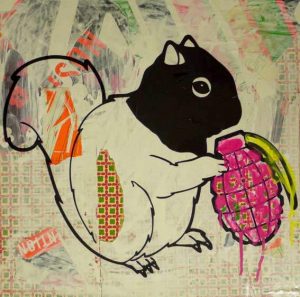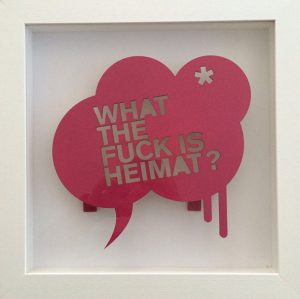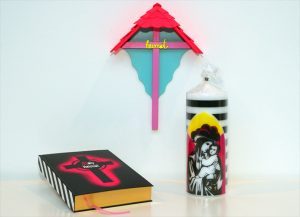Stefan Strumbel made a name for himself in particular by reinterpreting traditional cultural artifacts such as cuckoo clocks, anchors and crucifixes, and also by exaggerating elements of Street Art and Pop Art.
He replaces important elements of the cuckoo clock, such as traditional carved decorations, with motifs dealing with themes of violence, pornography and death.
In doing so, he contextualises the objects in a completely new and often provocative way. At first glance, these objects do not unveil their often disturbing content, but come across as beautifully shaped wooden sculptures. With their colorful and bright surfaces, these works of art are reminiscent of light and shiny pieces of Pop Art. However, Strumbel creates a uniquely artificial and artistic aesthetic, used to form extreme exaggerations of content.
Another important aspect of his work relates to the concept of “Heimat”, the German word for “home”. Its full intrinsic meaning however, which loosely alludes to heritage, cannot be fully conveyed in English. Strumbel raises significant questions of identity with his work. How do I define “home”? How do I view myself? How can I project myself onto the outside world?
With his art, Strumbel instigates a shift in societal values: traditional ideals, clichéd notions of home and the reality of the individual are dismantled and transformed into something aesthetical that then becomes an allegory of the societal status symbol. He actuates the mechanism of a society which, in its desire and pursuit of consumption, surrenders to the medium’s constant appeal to status. By means of these altered objects, Strumbel successfully creates an illusionary world that mirrors the sickness of society.
In the German village of Goldscheuer, the artist reconstructs the interior of the integrated Catholic Church of Mary. Strumbel approached the church with the idea of an entirely modern intervention. After initial skepticism about the project, he soon had the support of the entire municipality; Pastor Thomas Braunstein even praised Strumbel’s work as “a gift from heaven.” The reopening of the newly designed church on July 1st, 2011 was covered by all media outlets: Leading print publications such as “Der Spiegel” and “FAZ” published articles about the six-metre-tall Madonna, dressed in traditional Black Forest garb and holding infant Jesus in her arms above the entrance. LED light shines on speech bubbles and comic elements, all of which contribute to decorate the Catholic Church in an innovative fashion.
The New York Times recently asked the artist to do the cover for their magazine.
Stefan Strumbel (* 1979) lives and works in Offenburg.





